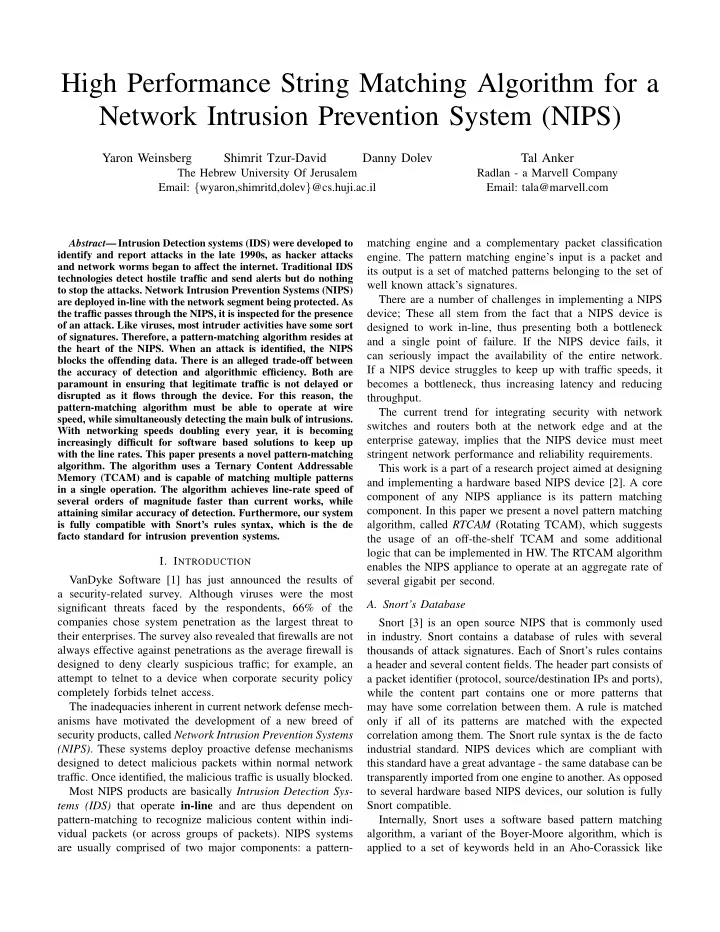

High Performance String Matching Algorithm for a Network Intrusion Prevention System (NIPS) Yaron Weinsberg Shimrit Tzur-David Danny Dolev Tal Anker The Hebrew University Of Jerusalem Radlan - a Marvell Company Email: { wyaron,shimritd,dolev } @cs.huji.ac.il Email: tala@marvell.com matching engine and a complementary packet classification Abstract — Intrusion Detection systems (IDS) were developed to identify and report attacks in the late 1990s, as hacker attacks engine. The pattern matching engine’s input is a packet and and network worms began to affect the internet. Traditional IDS its output is a set of matched patterns belonging to the set of technologies detect hostile traffic and send alerts but do nothing well known attack’s signatures. to stop the attacks. Network Intrusion Prevention Systems (NIPS) There are a number of challenges in implementing a NIPS are deployed in-line with the network segment being protected. As device; These all stem from the fact that a NIPS device is the traffic passes through the NIPS, it is inspected for the presence of an attack. Like viruses, most intruder activities have some sort designed to work in-line, thus presenting both a bottleneck of signatures. Therefore, a pattern-matching algorithm resides at and a single point of failure. If the NIPS device fails, it the heart of the NIPS. When an attack is identified, the NIPS can seriously impact the availability of the entire network. blocks the offending data. There is an alleged trade-off between If a NIPS device struggles to keep up with traffic speeds, it the accuracy of detection and algorithmic efficiency. Both are paramount in ensuring that legitimate traffic is not delayed or becomes a bottleneck, thus increasing latency and reducing disrupted as it flows through the device. For this reason, the throughput. pattern-matching algorithm must be able to operate at wire The current trend for integrating security with network speed, while simultaneously detecting the main bulk of intrusions. switches and routers both at the network edge and at the With networking speeds doubling every year, it is becoming enterprise gateway, implies that the NIPS device must meet increasingly difficult for software based solutions to keep up with the line rates. This paper presents a novel pattern-matching stringent network performance and reliability requirements. algorithm. The algorithm uses a Ternary Content Addressable This work is a part of a research project aimed at designing Memory (TCAM) and is capable of matching multiple patterns and implementing a hardware based NIPS device [2]. A core in a single operation. The algorithm achieves line-rate speed of component of any NIPS appliance is its pattern matching several orders of magnitude faster than current works, while component. In this paper we present a novel pattern matching attaining similar accuracy of detection. Furthermore, our system is fully compatible with Snort’s rules syntax, which is the de algorithm, called RTCAM (Rotating TCAM), which suggests facto standard for intrusion prevention systems. the usage of an off-the-shelf TCAM and some additional logic that can be implemented in HW. The RTCAM algorithm I. I NTRODUCTION enables the NIPS appliance to operate at an aggregate rate of VanDyke Software [1] has just announced the results of several gigabit per second. a security-related survey. Although viruses were the most A. Snort’s Database significant threats faced by the respondents, 66% of the companies chose system penetration as the largest threat to Snort [3] is an open source NIPS that is commonly used their enterprises. The survey also revealed that firewalls are not in industry. Snort contains a database of rules with several always effective against penetrations as the average firewall is thousands of attack signatures. Each of Snort’s rules contains designed to deny clearly suspicious traffic; for example, an a header and several content fields. The header part consists of attempt to telnet to a device when corporate security policy a packet identifier (protocol, source/destination IPs and ports), completely forbids telnet access. while the content part contains one or more patterns that The inadequacies inherent in current network defense mech- may have some correlation between them. A rule is matched anisms have motivated the development of a new breed of only if all of its patterns are matched with the expected security products, called Network Intrusion Prevention Systems correlation among them. The Snort rule syntax is the de facto (NIPS) . These systems deploy proactive defense mechanisms industrial standard. NIPS devices which are compliant with designed to detect malicious packets within normal network this standard have a great advantage - the same database can be traffic. Once identified, the malicious traffic is usually blocked. transparently imported from one engine to another. As opposed Most NIPS products are basically Intrusion Detection Sys- to several hardware based NIPS devices, our solution is fully tems (IDS) that operate in-line and are thus dependent on Snort compatible. pattern-matching to recognize malicious content within indi- Internally, Snort uses a software based pattern matching vidual packets (or across groups of packets). NIPS systems algorithm, a variant of the Boyer-Moore algorithm, which is are usually comprised of two major components: a pattern- applied to a set of keywords held in an Aho-Corassick like
Recommend
More recommend